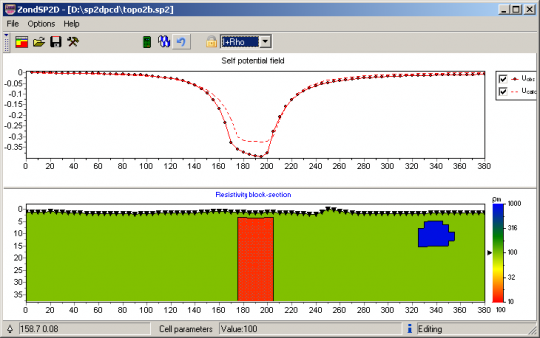ZondSP2D
ZondSP2d program is desined for two-dimensional interpretation of self-potential data by (land and borehole variants).
Self-potential field method is based on studying of the natural electric fields that generate in rocks because of various physical and chemical processes. Small self potentials of diffuse-adsorbtsion and filtering nature exist practically everywhere. Intensive fields of redox nature are observed only over sulphide and graphit deposits. As a rule electronic conductors located in the ionic media are the search objects of self-potential field method. Electric charges as sources of natural electric field are formed on the boundaries of such objects.
Each cell of model has next ptoperties: resistivity , type conductivity (electronic or ionic). On cells borders with differ types of conductivity sources of the natural field are formed (functional relation of the source intensity vs depth that characterizes spatial distribution of redox factors is used).
ZondSP2d represents ready solution for self-potential method, and solves wide range of problems from mathematical modeling to field data interpretation. Convenient interface and variety of data visualization features allow to solve wide range of geological problems with maximum effectiveness.
ZondSP2d uses simple and clear data format which allows easily combining various systems of observation, including different variants of the topography setting up and other additional information.
Important stage which prevents field measurement is mathematical modeling of petrophysical structure of work site. Modeling gives a chance to make a choice of optimum parameters of the observation system for decision of formulated geological problem.
As the general task of the program is inversion of resistivity and charges, some variants of inverse problem decision are realized in ZondSP2d, basic of them are: smoothing inversion – to get smooth model and focusing — to get piece-smoothed model of petrophysical parameters with depth.
While program was designed special consideration given to a priori data accounting. Because of equivalence of inverse geophysical problems, quality of the obtained results strongly depends on the amount of a priori data used. In ZonSP2d there is possibility of weights setting for measurements, fixing and limits making of changing features of different cells, using of a priori model as reference in inversion. There is also possibility to import and display results of measurements by other methods and cross-boreholes data that improved quality of results.
Version 27 / 8 / 2017 | Software: download
